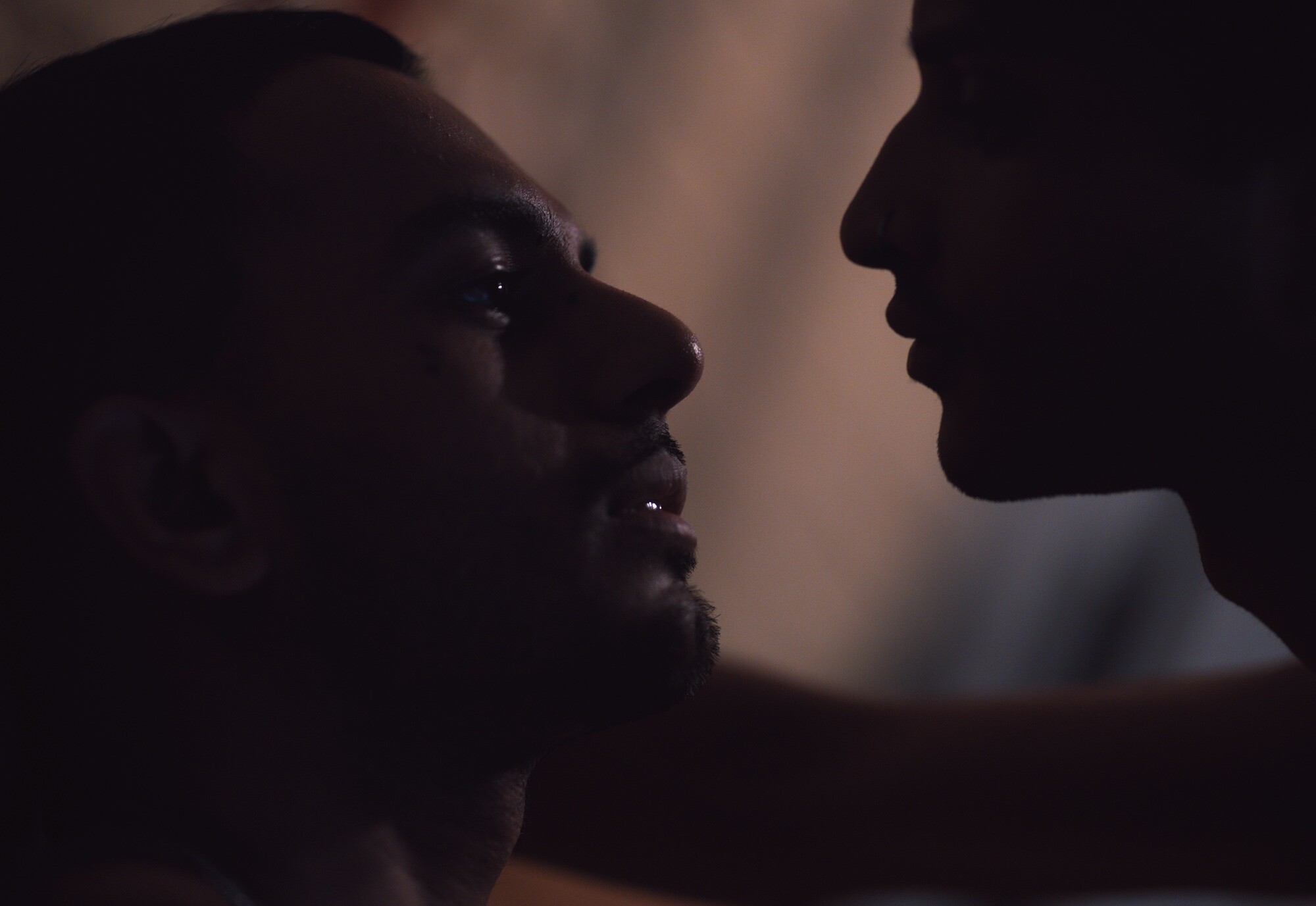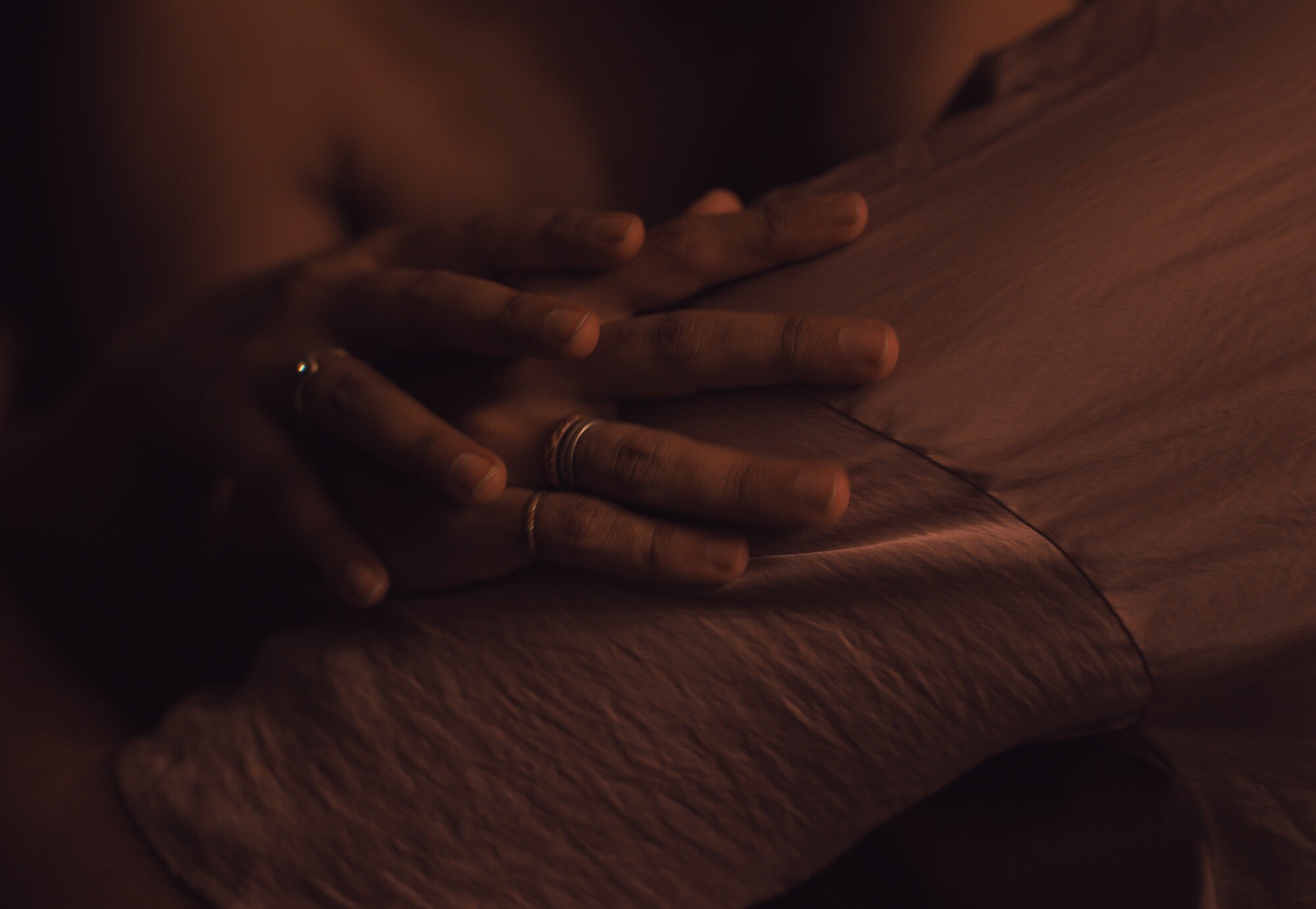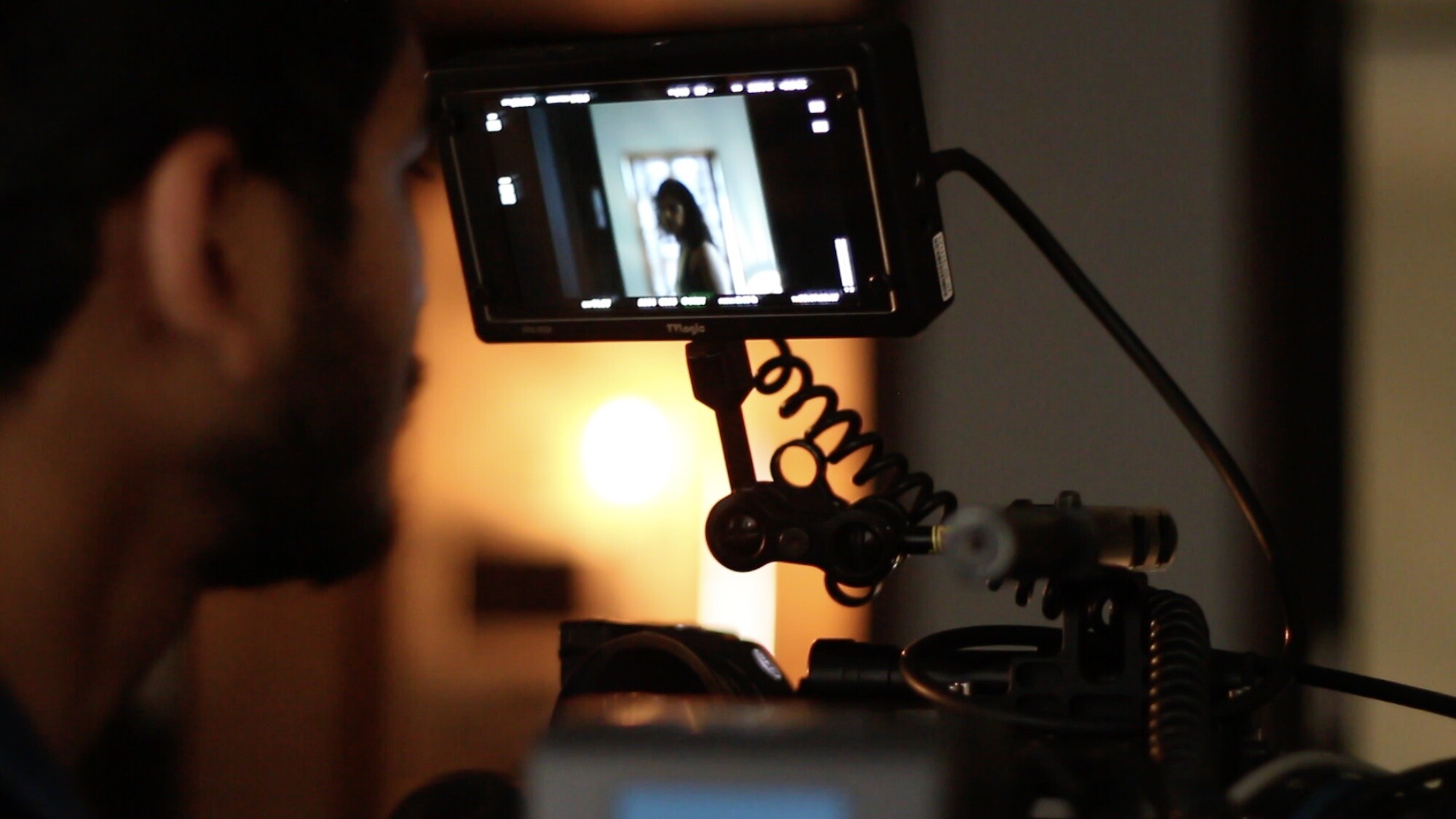
Based on Varsha Panikar’s poetry series of the same name, Bodies of Desire is a visual poem centring on the tender intimacy created by group of lovers. Panikar adapted the series for screen alongside Co-Director Saad Nawab to give the words an added visualisation, honing in on the tactility that film offers. Bodies of Desire is also a portrait of queer relationships, showcasing the beauty found in presentations of love between partners of multiple sexualities. It’s a really beautiful film that captures an honest sense of longing between companions, the raw and honest visuals a result of Panikar and Nawab’s decision to cast non-actors who then went through a series of intimacy workshops to become comfortable in front of the camera. Both Panikar and Nawab join us below and explain the necessity of these workshops in addition to the creative motivations behind the film’s natural look and 4:3 aspect ratio.
I read that Bodies of Desire is adapted from a poetry series you started posting on Instagram. What inspired that initial series and what led to you translating it into a film?
Growing up, I don’t remember seeing a single character or film that I could relate to. For far too long film and TV has systematically taught the audience how to react to queerness and anyone who transgresses from the traditional and conservative box of heteronormativity and the binary. They taught society to laugh at us, to mock us, to threaten us, look at us in fear, disgust and mistrust, and worse, excluded us in ways that rendered us invisible, made us highly prone to hostility and persecution on a daily basis, and pushed us and our stories into the shadows. For someone like me, had I grown up watching this sort of positive depiction of bodies, desire, love, and queerness, life would have turned out quite differently. So deep down, I guess I just wanted to make something I wish I had grown up watching.
I wanted to create a portrait of intimacy, of longing, of desire, of embrace, and capture moments amongst lovers where only they exist, and the rest of the world becomes background noise.
Bodies of Desire is adapted from my series, by the same name, which I started posting on Instagram. It captured lovers in moments of intimacy and passion, coupled with poems that dealt with themes of identity, empathy, companionship, the fleeting nature of certain relationships, loneliness, despair, loss, rediscovering passion, love, and the sense of self through confessions and epiphanies that arise out of accepting and surrendering to your desire. I wrote it at a time when I was on a journey to rediscover and embrace my own identity so as I kept adding to the series, it evolved into an archive of encounters and experiences.
It was the same with the film. I wanted to create a portrait of intimacy, of longing, of desire, of embrace, and capture moments amongst lovers where only they exist, and the rest of the world becomes background noise. I had always wanted to adopt a film from the series someday, but it all started when Kaushal Shah, our cinematographer showed interest in Bodies of Desire. One day he texted me on Instagram and proposed we capture the series in moving images and we did!

I guess one of the main challenges in creating a film like this is being able to aid you actors in allowing them to be intimate with each other comfortably in front of the camera. How did you find creating the intimacy of the film from a practical standpoint?
Not all intimacy is erotic or romantic; there is intimacy in comradeship, friendship, family, and there is also intimacy in thinking together, and creating together, which emerges from the same source as love and desire. The approach to the film was just that – intimate and collaborative. First step, was the text and the treatment, which was put together with the original series in mind. Next step was casting.
Diversity was key so we spent a long time looking for the right cast, and in the process met some of the most brilliant people we’ve known. The process here was crucial since we were mostly looking for non-trained performers who could bring a certain rawness and authenticity to the film. Our initial casting round was more of a questionnaire, followed by a one-on-one audition to understand what intimacy and desire meant to each one of them, what their preferences were with regards to their preferred pairing with a co-actor, their inhibitions, their concerns.
The intimacy between the characters is something we worked on over a period of time, especially since most of our cast is made up of non-trained actors. These were followed by an intimacy workshop, on-location choreography and rehearsals prior to the shoot, all of which further helped us in building chemistry, exploring physical and emotional dynamics, and most importantly, helped us draw a clear boundary of consent and define the degree of intimacy everyone was comfortable with. It’s essential to build an atmosphere of trust, comfort and honesty before you embark on a project so intimate. It allows the performers to artistically be vulnerable in front of the camera, and in turn, helps us to create a film which feels natural and un-inhibited.



What do you think your non-actors learned over that time that allowed them to be present in front of the camera?
During the workshop/audition, everybody, including us got to participate. We had a diverse group of people from various backgrounds and identities, and one notable thing that everybody discovered through the workshop, was a certain fluidity most of them felt in their own sexuality which they hadn’t expected but were quick to embrace, and that is the thing with intimacy and self-discovery. It is ever evolving.
Soon after we finalised the cast and the pairing, we discovered each couple’s physical language of intimacy. One thing we asked the cast during the initial rounds of the casting was, “things that reminded them of intimacy”, and for the majority it was “the touch” and then the “smell”. When you think of moments of embrace, the touch, the taste, the smell, the first thing that visually strikes you is the touch. The slight brushing of hands with one another, interlacing fingers, their caress on someone else’s skin, their face, palms pressed together. It’s erotic and romantic, it creates tension and anticipation. There is also a certain profoundness and soothing comfort in touch, and its caress has the power to heal. It is such a simple act, but it holds great power and has been a subtle metaphor for queer relationships for a very long, in literature, art and films.
It’s essential to build an atmosphere of trust, comfort and honesty before you embark on a project so intimate.
It was fascinating. But in hindsight, a lot of what you see, also came out through the exercises we used during workshops and the choreography, and touching through hands became the language of intimacy, that everyone could relate to with ease and authenticity. Varsha had also created a Bodies of Desire playlist, which resonated with the mood and tone we wanted to achieve in the movements and action, which became quite a hit with the cast during the workshop. Eventually, they all chose their favourite tracks from it, to be played in the background, for the various emotions they were to perform during filming.

How long did it take you to capture everyone on the day of the shoot? Were you able to prepare the actors for the presence of cameras?
We had exactly ten hours to shoot at the location and a very limited budget so it was imperative that we knew what we were going to shoot and how we were going to achieve it. Hence, right before filming we did the final choreography workshop on location, in the final costume, which gave the cast enough time to familiarise themselves with the space, and feel comfortable in the presence of the camera and the rest of the crew. We wanted them to know exactly what we would be doing because once you are on set, everything gets very technical, and we didn’t want the cast to feel overwhelmed by it all.
You briefly mentioned costuming there. What was your approach when it came to the look of your characters?
When it came to styling and the look for the cast, we wanted to keep it natural and real, by maintaining the authenticity of the various skin tones we had, unlike the whitewashed and photoshopped skin tones we have gotten used to seeing in our fairness-obsessed Indian advertising and media. Kaushal wanted to showcase brown bodies in all their glory. For styling, Omkar Sharma, one of the cast members, who is also a designer and stylist, rose to the occasion and took on the task. We wanted to let the cast retain their sense of personal styles so they would feel comfortable and that’s what we did.
What led you to shoot in a 4:3 aspect ratio?
The decision to shoot in 4:3 was also a conscious choice. I have personally always been enamored by the 4:3 aspect ratio. Perhaps, because some of my favorite films were shot on 16mm and 35mm film in 4:3. It allows the audience to connect with characters more intimately and it looks aesthetically more natural, at least to me. Since Bodies of Desire was about exploring intimacy, I had always imagined it in 4:3, and after discussion with Kaushal Shah, it became apparent that it was the obvious choice. It helped highlight the subtleties of the performances, the performers, the bodies, and the intimacy between them. It felt more poetic and seemed apt for a film trying to break out of the dominant cis-heteronormative structure of the Indian film industry. Moreover, 4:3 lends a certain nostalgia one cannot deny or resist.


It’s fascinating hearing about all these small details that add up to create the overall authenticity of the film. What other elements do you think contribute towards that sensibility?
In the end, I think it was all of the prep we did with our amazing cast that played a massive role in how authentic it looks. That mixed with Kaushal’s cinematic brilliance and the fluidity of his gaze brought the poetry to life. He is a visual poet and extremely sensitive towards the overall vision of the film and the director. Eventually, Cornelia Nicolăeasa’s edit and Mark Spanoudakis’ music heightened everything we shot and made it sensorial and visceral.
This film has helped us evolve as humans and storytellers in immeasurable ways.
However, post-production was no easy task. We had a shoestring budget so it was getting very hard for us to find a team in India, especially since the global pandemic had pretty much taken over the world. Asawari Jagushte, our producer, tapped into some contacts across the globe and found Cornelia from Romania and Mark from Athens, Greece, and the rest is history. They resonated with the language we wanted to create from the get go. Cornelia pieced together the whole film with absolute brilliance, maintaining the organic nature of intimacy, by embracing its highs and its lows. Mark designed a soundscape, that was sensorial by mixing electronic and live sounds. It heightened the reality depicted in the poetry, imagery and choreography.
In fact, we communicated with Mark only through emails, many, many emails. It only goes to prove how clear communication doesn’t require you to sit across from each other and talk. It can happen across borders with absolute ease. Reminds me of something Mark said to us once, “It is so important to have these conversations together, on a global level, because right now everything, all conversations are happening in isolation or only within certain groups, and we fail to realize that the only way forward is together.”



I think Bodies of Desire is such a great example of showing how filmmakers can learn about the world through the making of their films as opposed to a more didactic approach in expressing a singular viewpoint that pre-exists before the process has even begun. What would you say you learned the most through making the film?
This whole film has been such a learning for both of us. We have been directing together for a while now, but this film has helped us evolve as humans and storytellers in immeasurable ways. The film was made with a lot of love and we are so grateful for how it has been received around the globe. It’s more than what we had imagined and we are happy others could resonate with it. But it was the embodiment of desire in performance by the whole cast, Kaushal’s cinematic brilliance, Cornelia’s killer cutting skills, Mark’s transcendental skill with sound, and Asawari’s unrelenting spirit that brought Bodies of Desire this far.
Hopefully this will compel others to take back their narrative and make and produce more queer works of art.
At the core it is a story of finding the love for self and acceptance of self, unabashedly through passion and desire. It is a universal and primal emotion, and we hope people see it as that and hopefully, this will compel others to take back their narrative and make and produce more queer works of art, which is told from our perspective and our voices, and not how it appears to an outsider, and maybe, one day, we can look at works like these as not just queer, but simply human, because that’s what they are.

What are you both working on presently in regards to film projects?
Varsha: I am currently developing visual-poetry from my series Origami Folds which delves into themes of identity, oppression and trauma as conditions of globalized society and cultures, through the lens of South Asian, queer and marginalized bodies. As filmmakers and creators, Asawari Jagushte, my producer and I have also started a cross-disciplinary collective, Star Hopper Studios, that focuses on curation, distribution and producing experimental queer and intersectional narratives across various mediums and formats.
Saad: I am in the middle of writing and developing a couple of features. One is about an artist forced to adopt someone else’s dreams. Their unexpected success leads them on a journey where they face discrimination and self-destructive turmoil that might undo them. The other feature, which has progressed to the second round of the Sundance development track is a story of two siblings from a marginalized community amidst the backdrop of the COVID pandemic in India. It offers an insight into the human condition of an oppressed people and their will to survive and rise up in a country that is not willing to cure itself of its caste and religious divide.


